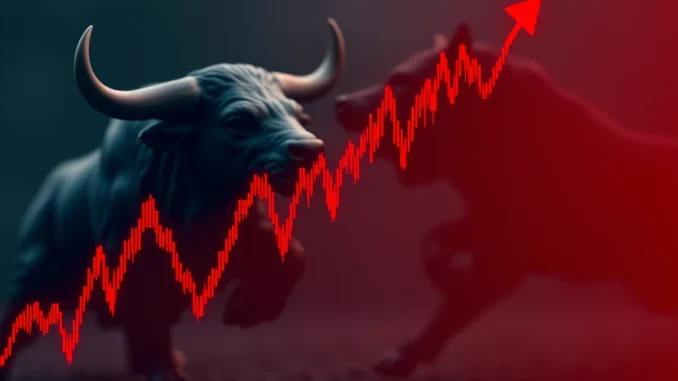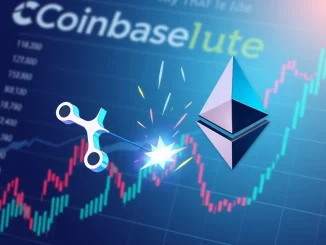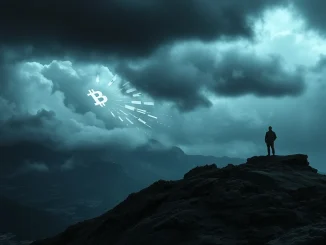
Is Ethereum (ETH) currently undervalued? That’s the burning question on many crypto enthusiasts’ minds as market volatility continues to dominate headlines. Adding fuel to the fire, Qiao Wang, a prominent figure and founding partner at Alliance DAO, has publicly stated that Ethereum appears to be significantly oversold. His recent comments on social media platform X have ignited discussions across the crypto sphere, drawing comparisons to some of the most dramatic downturns in crypto history. Let’s dive into Wang’s perspective and what it could mean for the future of ETH.
Ethereum Oversold: Echoes of Crypto Crashes?
Qiao Wang’s statement that Ethereum is oversold isn’t just a casual market observation; it’s a weighty comparison to critical moments in cryptocurrency history. He specifically draws parallels between the current ETH price levels and those witnessed during:
- The 2021 Terra Collapse: A catastrophic event that sent shockwaves through the entire crypto market, wiping out billions in value and shaking investor confidence.
- The 2018 Deep Bear Market: A prolonged period of market decline that tested the resilience of even the most ardent crypto believers.
- The Aftermath of the 2016 DAO Hack: An early crisis in the Ethereum ecosystem that raised serious questions about smart contract security and governance.
To have a seasoned investor like Wang equate the current Ethereum situation to these events is noteworthy. It suggests a potentially significant disconnect between the perceived value of ETH and its current market price. His tweet, highlighting this oversold condition, immediately sparked debate and analysis within the crypto community. Many are now pondering whether this perceived undervaluation presents a golden opportunity or a potential value trap.
The Temptation of Buying ETH: A Contrarian View?
Adding another layer of intrigue to Wang’s comments is his explicit mention of the temptation to buy ETH at these prices. He acknowledges the allure of acquiring Ethereum when it appears to be trading at levels reminiscent of major market bottoms. This sentiment resonates with the classic investment adage of “buy low, sell high.” However, Wang’s situation is particularly nuanced given his recent investment history with Ethereum.
It’s crucial to remember that just last month, Wang revealed in a podcast interview that he had sold his entire ETH holdings in the previous year. After a decade-long investment in Ethereum, he cited a belief that its growth potential was nearing exhaustion. This revelation adds complexity to his current statement. Is his “temptation” to buy now a genuine shift in perspective, or is it a more tactical observation about short-term market dynamics?
Here’s a quick recap of Wang’s seemingly contradictory stance:
| Timeline | Action/Statement | Implication |
|---|---|---|
| Last Year | Sold all ETH holdings | Belief in limited long-term growth for ETH |
| Recently (X Post) | ETH is oversold, buying is tempting | Short-term market opportunity despite long-term concerns? |
This apparent contradiction raises questions. Could Wang be suggesting a short-term trading opportunity based on the oversold nature of ETH, even while maintaining a more bearish long-term outlook? Or has something fundamentally shifted his perspective in recent weeks?
Qiao Wang’s Crypto Market Analysis: Layer-2s vs. Solana
To further understand Wang’s viewpoint, it’s essential to consider his broader market analysis, particularly his perspective on Ethereum’s layer-2 scaling solutions. In the same podcast where he disclosed selling his ETH, Wang expressed skepticism about the future outperformance of Ethereum’s layer-2 ecosystem compared to competitors like Solana (SOL).
He estimates that Ethereum’s layer-2 solutions only have a 10–20% chance of outperforming Solana. This is a significant statement, suggesting he sees greater growth potential in alternative layer-1 blockchains like Solana, rather than in scaling solutions built on top of Ethereum. This perspective likely plays a crucial role in his decision to exit his ETH position and may also influence how we interpret his current “oversold” observation.
Let’s break down Wang’s layer-2 vs. Solana thesis:
- Limited Layer-2 Outperformance: Wang believes Ethereum’s layer-2 solutions are unlikely to significantly surpass Solana in terms of growth and adoption.
- Solana’s Potential: He implicitly suggests that Solana offers a more compelling investment opportunity in the layer-1 blockchain space.
- Impact on ETH Value: If layer-2 solutions underperform, it could limit the overall growth and value accrual to ETH itself.
Navigating the ETH Price Volatility: What Should Investors Do?
Qiao Wang’s insights offer a valuable perspective on the current ETH price dynamics. His assessment that Ethereum is oversold, coupled with his acknowledgement of the buying temptation, presents a complex scenario for investors. On one hand, the historical comparisons to market crash levels could signal a genuine undervaluation. On the other hand, his previous sale of ETH and skepticism about layer-2s suggest potential long-term headwinds.
So, what actionable insights can we glean from this?
- Do Your Own Research (DYOR): Wang’s opinion is one data point. Conduct thorough research before making any investment decisions. Analyze Ethereum’s fundamentals, on-chain metrics, and broader market conditions.
- Consider Risk Tolerance: Investing in crypto is inherently risky. Assess your risk tolerance and only invest what you can afford to lose. An oversold market can still go lower.
- Diversification: Don’t put all your eggs in one basket. Diversify your crypto portfolio across different assets and sectors to mitigate risk.
- Long-Term vs. Short-Term Strategy: Are you looking for a quick trade based on oversold conditions, or a long-term investment? Wang’s comments could be interpreted for both strategies, but understanding your own timeframe is crucial.
- Monitor Layer-2 and Solana Developments: Keep an eye on the progress and adoption of Ethereum’s layer-2 solutions and Solana’s ecosystem. These developments will likely influence the future trajectory of both ETH and SOL.
Conclusion: The Alluring Yet Uncertain Path of Ethereum
Qiao Wang’s analysis paints a fascinating, albeit complex, picture of Ethereum’s current market position. The notion that ETH is oversold and presents a tempting buying opportunity is undeniably attractive, especially given the historical comparisons to major crypto market downturns. However, his past actions and long-term concerns about Ethereum’s growth potential inject a dose of caution into the narrative.
Ultimately, Wang’s commentary serves as a powerful reminder of the inherent volatility and uncertainty in the cryptocurrency market. While the temptation to capitalize on perceived undervaluation is strong, investors must proceed with diligence, critical thinking, and a comprehensive understanding of both the potential rewards and the inherent risks associated with Ethereum and the broader crypto landscape. Whether this “oversold” state truly marks a turning point for ETH remains to be seen, but the conversation sparked by Wang is undoubtedly crucial for navigating the ever-evolving crypto narrative.



